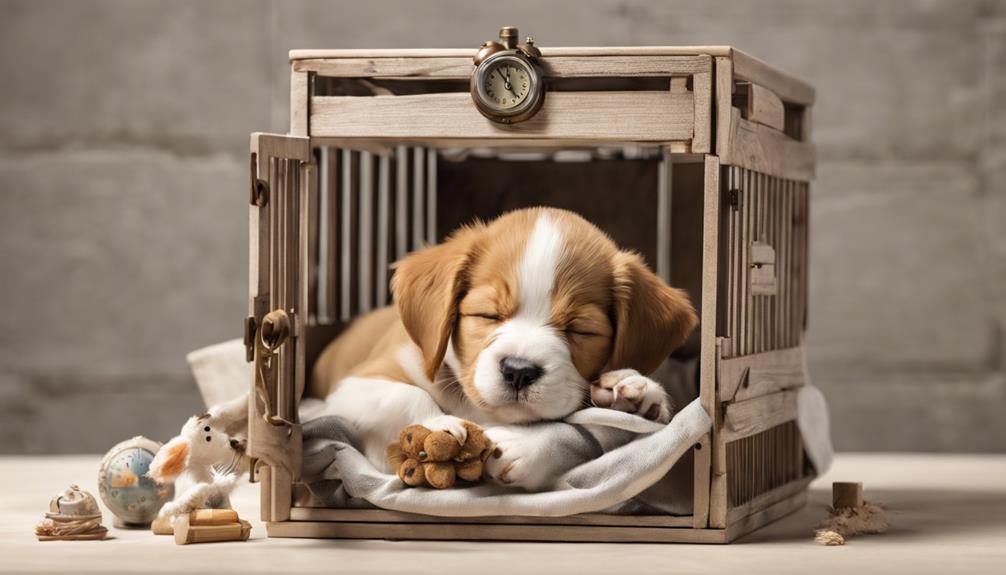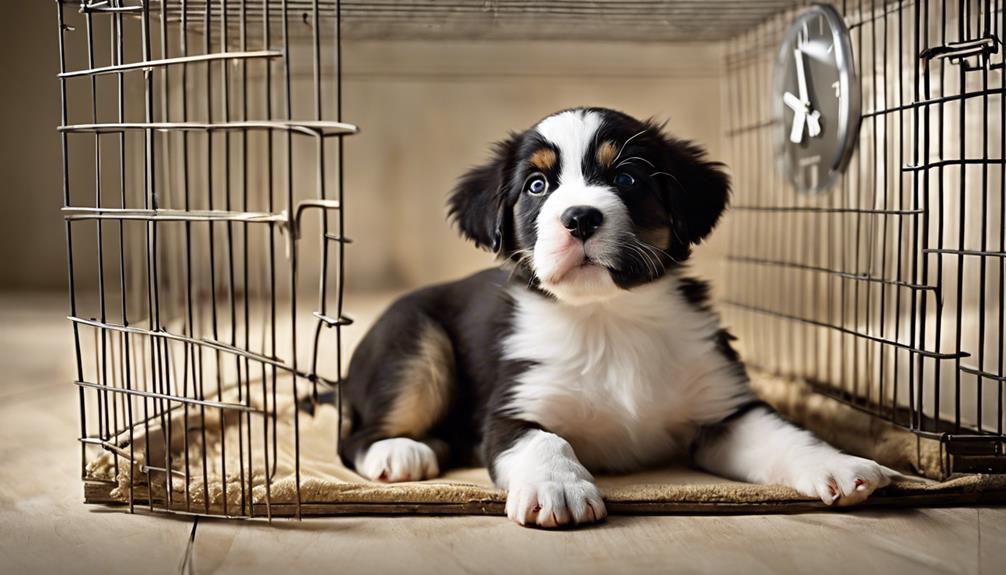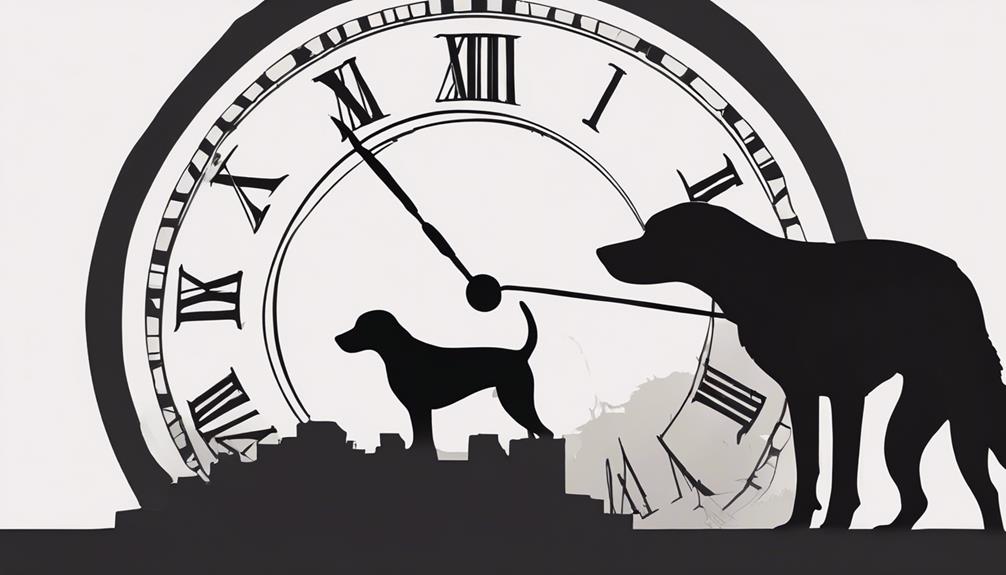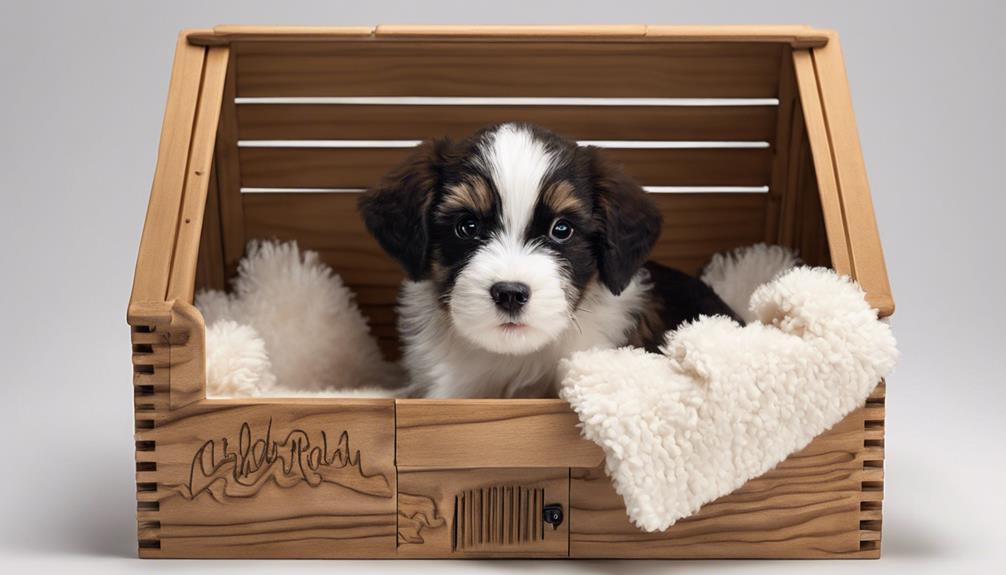When crate training your puppy, it is important to adhere to a schedule that is suitable for their age to ensure successful training. Begin by slowly introducing the crate and utilizing positive reinforcement methods to create a positive connection. It is essential to set a regular schedule for bathroom breaks and meals, encourage good behavior, and keep a structured routine for nap and play times.
Remember to monitor your puppy's behavior during crate training sessions and gradually increase the duration. By following these basics, you can set the groundwork for a well-behaved companion.
Key Takeaways
- Start crate training at 8-10 weeks with short sessions.
- Gradually increase crate time for independence at 10-14 weeks.
- Focus on obedience training from 14-18 weeks for consistency.
- Introduce advanced commands at 4-6 months for mental stimulation.
- Refine skills and socialize between 6 months to 1 year for well-rounded development.
Crate Training Basics
In crate training, it's important to gradually introduce your puppy to the crate using positive reinforcement techniques to create a positive association with this designated space. The crate should be seen as a safe haven for your puppy, a den-like environment where they can feel secure. When starting crate training, it's vital to confirm the crate is appropriately sized for your puppy. The size should allow them to stand up, turn around, and lie down comfortably.
Puppies have a natural instinct to keep their dens clean, making crate training an effective tool for housebreaking. By establishing a consistent schedule for potty breaks and crate time, you can help your puppy learn bladder control and develop good bathroom habits. Positive reinforcement, such as treats and praise, should be used when your puppy enters the crate willingly. This positive association will make them more likely to view the crate as a positive space. Remember, crate training should be age-appropriate and consistent to be effective in shaping your puppy's behavior.
Schedule for 8-10 Week-Old Puppies
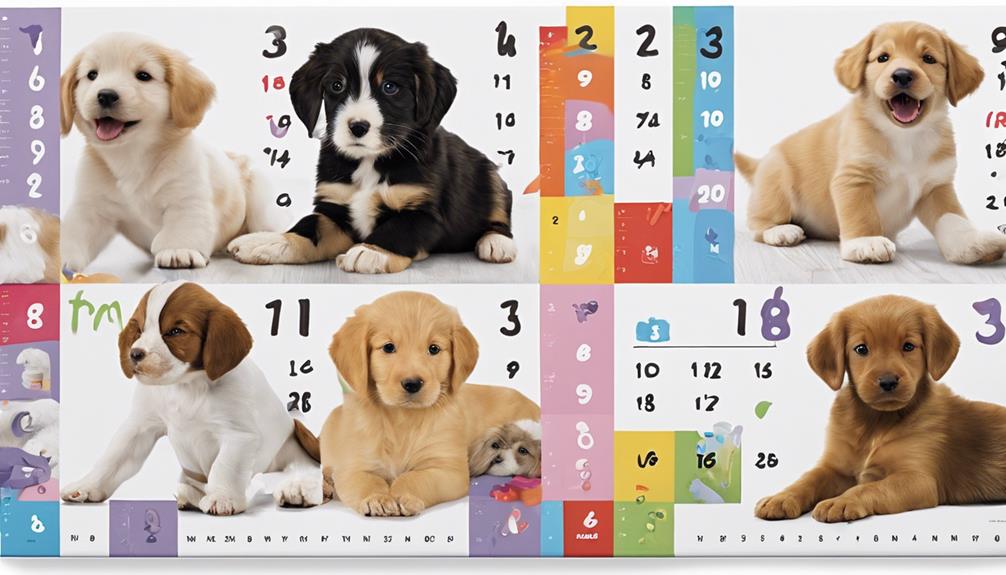
When raising 8-10 week-old puppies, it's essential to establish a consistent schedule for feeding and potty breaks. Our routine should include designated times for naps and play to balance rest and activity.
Additionally, incorporating structured crate training sessions will aid in housebreaking and promoting independence.
Feeding and Potty Breaks
To ensure the well-being of 8-10 week-old puppies, maintaining a consistent schedule for feeding and potty breaks is vital for their growth and training. Here are some essential guidelines to follow:
- Feeding Schedule: Provide meals every 3-4 hours to support the puppy's growth and development.
- Potty Training Schedule: Take the puppy out for potty breaks every 30-60 minutes to reinforce good elimination habits.
- Establish Routine: Implement a consistent schedule for feeding and potty breaks to create predictability for the puppy.
- Monitor Water Intake: Keep an eye on the puppy's water consumption and adjust potty break frequency accordingly to prevent accidents.
Nap and Play Times
Maintaining a structured routine for nap and play times is key to ensuring proper rest and stimulation for 8-10 week-old puppies. At this age, pups need 18-20 hours of sleep daily.
Incorporating short play sessions of 10-15 minutes every 1-2 hours helps prevent overtiredness. Utilize interactive toys or engage in gentle play to keep the pup's mind active during wake times.
Balancing nap times with play sessions is essential for healthy development. Remember, the goal is to provide enough rest for the puppy to grow and thrive while also offering stimulating activities to aid in their mental and physical well-being.
Crate Training Sessions
Our approach to crate training sessions for 8-10 week-old puppies involves gradually introducing them to the crate in short intervals while utilizing positive reinforcement techniques like treats and praise to foster a positive association with their new space.
- Start with short intervals: Begin by having brief sessions in the crate to prevent anxiety and stress.
- Positive reinforcement: Use treats and praise to encourage the puppy to see the crate as a comfortable and safe place.
- Monitor behavior: Keep an eye on how the puppy reacts during crate training to guarantee they're adapting positively.
- Increase duration gradually: As the puppy becomes more comfortable, slowly extend the length of the crate training sessions to help them acclimate.
Advancing Training Techniques
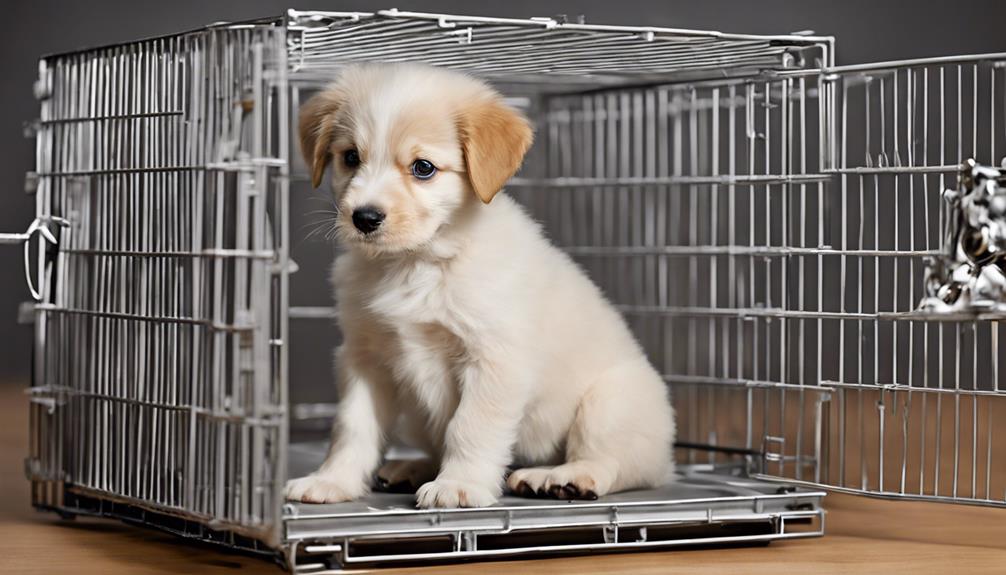
Let's explore advanced crate training techniques that include practicing commands like Stay and Leave-It. These exercises enhance obedience and mental engagement for your puppy.
Additionally, structured play sessions like fetch and tug can provide the necessary physical and mental stimulation for a well-rounded training regimen.
Advanced Crate Training
Implementing advanced crate training techniques involves reinforcing obedience skills, introducing complex commands, expanding socialization, and incorporating mental stimulation for thorough development.
- Reinforce advanced obedience training: Strengthen the puppy's obedience skills by practicing advanced commands regularly.
- Introduce complex commands: Teach commands like Stay, Leave-It, and Heel to enhance the puppy's skillset.
- Expand socialization: Expose the puppy to various environments, people, and animals to promote well-rounded social skills.
- Incorporate mental stimulation: Use interactive games and puzzle toys to challenge the puppy's cognitive abilities and prevent boredom.
Enrichment Activities for Dogs
Advancing your dog's training techniques through enrichment activities involves stimulating their mind and senses with engaging games and interactive toys. Puzzle toys, interactive games, and nose work are excellent ways to provide mental stimulation.
Physical exercise, such as fetch and agility courses, not only keeps your dog physically fit but also contributes to their overall well-being. Scent games, hide-and-seek, and treat-dispensing toys tap into your dog's natural instincts and offer mental engagement.
Varying training sessions with different levels of difficulty, duration, and distractions can enhance your dog's obedience skills. By incorporating these enrichment activities into your routine, you can keep your dog mentally sharp, physically active, and continuously improving their training abilities.
Positive Reinforcement Techniques
Utilizing high-value treats and praise is essential for reinforcing advanced commands such as Leave It and Drop It during dog training sessions. To enhance your puppy's cognitive abilities and obedience skills, consider the following positive reinforcement techniques:
- Gradually Increase Difficulty: Challenge your puppy with more complex commands to promote mental growth and responsiveness.
- Engage in Interactive Games: Keep training sessions dynamic and fun to maintain focus and enthusiasm to learn.
- Practice Off-Leash Reliability: Encourage obedience in safe, enclosed areas to improve your puppy's responsiveness and control.
- Consistent Reinforcement: Regularly reinforce advanced commands to solidify good behavior and foster a strong training foundation.
Leash Training and Socialization
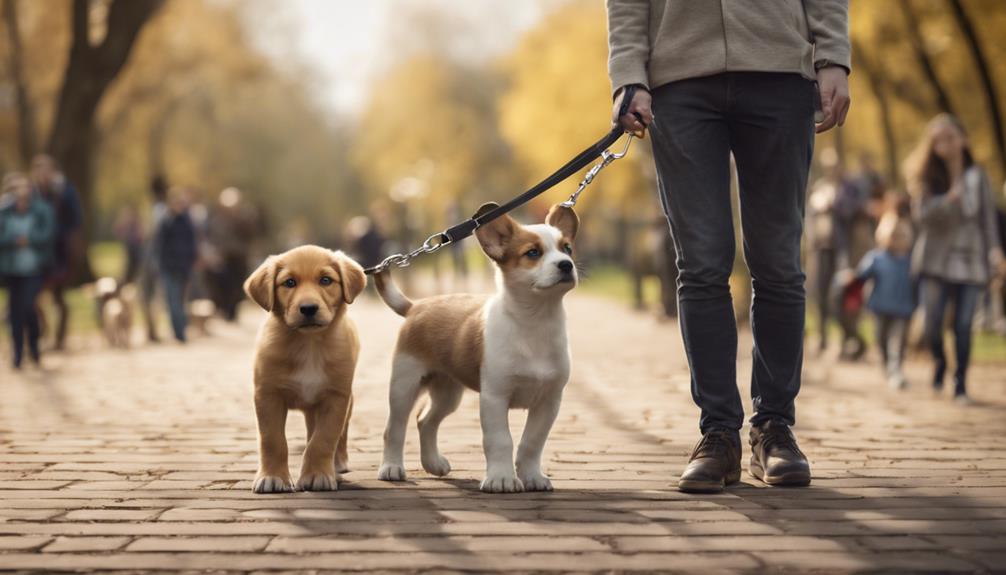
To effectively train your puppy to walk on a leash and socialize with others, start by gradually introducing the leash and exposing them to various people, animals, and environments. Leash training involves getting your puppy comfortable with wearing a leash and walking alongside you. Socialization is important for your puppy's development, helping them build confidence and prevent behavioral issues like pulling on the leash or fear of new situations. During socialization, introduce your puppy to different sights, sounds, and smells to avoid fear or aggression.
| Leash Training | Socialization |
|---|---|
| Get puppy used to leash | Expose to people and animals |
| Practice walking together | Introduce to new environments |
| Use positive reinforcement | Encourage positive experiences |
| Be consistent | Monitor reactions closely |
| Build puppy's confidence | Prevent fear or aggression |
Consistent and positive experiences during leash training and socialization are essential for your puppy's well-being. These practices lay a strong foundation for future training and guarantee a well-adjusted, sociable companion.
Consistency and Positive Reinforcement
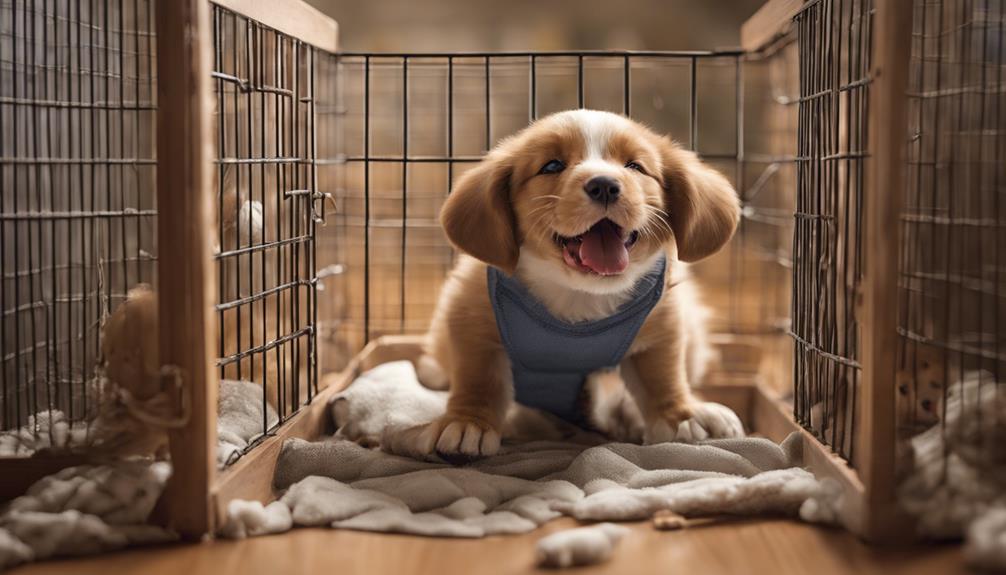
When moving from leash training and socialization to crate training, maintaining consistency and utilizing positive reinforcement are key components in fostering a well-behaved and comfortable puppy. Here's how to effectively incorporate these elements into your crate training schedule:
- Consistency: Use the same commands and approach every time you engage in crate training. Consistency helps your puppy understand what's expected of them, reducing anxiety and promoting learning.
- Positive Reinforcement: Reward your puppy with treats, praise, or playtime when they exhibit desired behaviors during crate training. Positive reinforcement reinforces good behavior and motivates your puppy to continue behaving well.
- Structured Schedule: Establish a routine that includes regular potty breaks and dedicated playtime within your crate training schedule. A structured schedule helps your puppy anticipate their needs and promotes successful crate training.
- Behavior Management: Consistent application of commands, routines, and positive reinforcement techniques aids in effective behavior management during crate training. By sticking to a structured approach, you can help your puppy develop good habits and behaviors within their crate.
Progressive Training for Growth
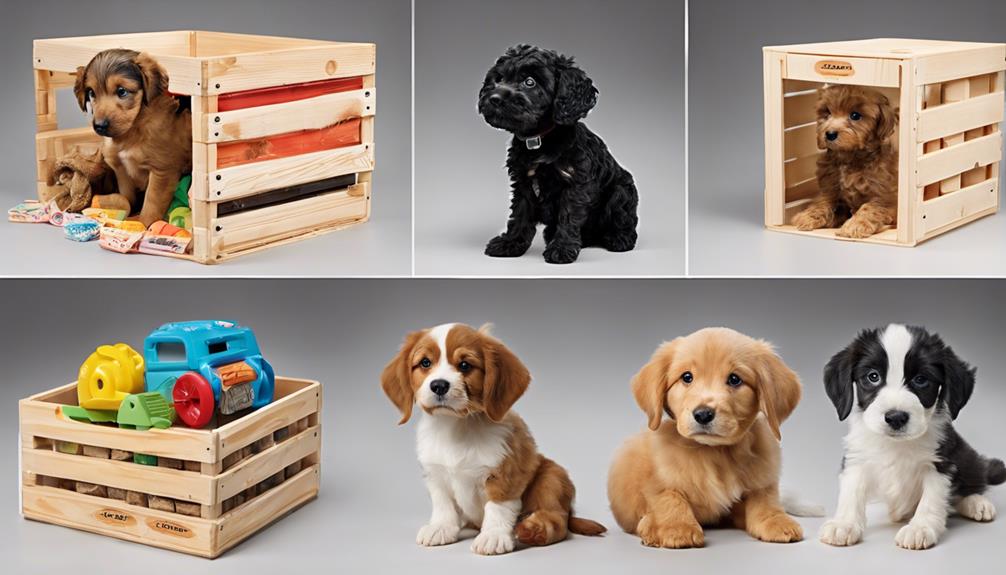
Gradually introducing crate training to puppies between 8-10 weeks old sets the foundation for their growth and development in obedience and behavior management. As puppies reach 10-14 weeks, the focus shifts towards building independence and honing housebreaking skills. This period is critical for instilling good habits and routines.
Moving on to 14-18 weeks, the emphasis shifts to strengthening obedience training and impulse control. It's a time to work on establishing boundaries and reinforcing positive behaviors. By the time puppies are 4-6 months old, they're ready to practice advanced commands and develop off-leash reliability. This stage is pivotal for enhancing their listening skills and response to commands.
Between 6 months to 1 year, it's essential to refine obedience skills and engage in regular socialization to guarantee a well-rounded and well-adjusted dog. This progressive training approach tailored to the puppy's age ensures a thorough development in all aspects of their behavior and skills.
Tailoring the Schedule for Your Family
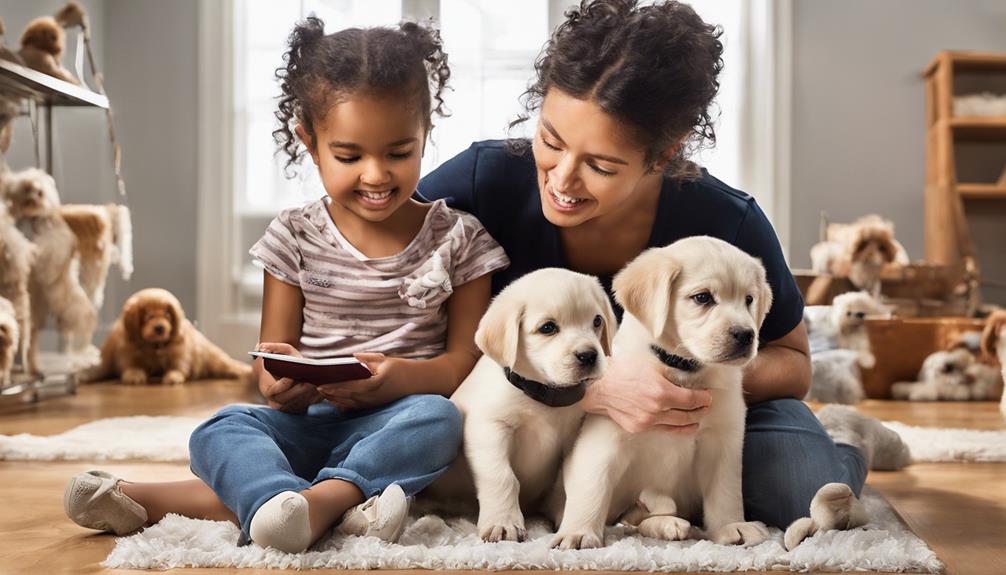
Tailoring our family's schedule to accommodate crate training requires consistent communication and collaboration to guarantee the puppy's success. To make sure effective training and a harmonious environment, our family should consider the following:
- Consistency: All family members must use the same commands and follow the set schedule to avoid confusing the puppy.
- Vital: It's important to reinforce desired behaviors consistently across all family members so the puppy understands what's expected of them.
- Correcting Unwanted Behaviors: Promptly and consistently addressing unwanted behaviors helps the puppy learn right from wrong and accelerates their training progress.
- Establishing Routine: Creating a structured routine and maintaining a consistent training approach throughout the family will greatly contribute to successful crate training.
Transitioning to Older Dogs

To smoothly introduce older dogs to crate training, it's crucial to understand their established behaviors and take gradual steps towards creating a positive association with the crate.
Older dogs may require a slower shift due to their ingrained habits. Begin by making the crate a welcoming and comfortable space for them. Consider using calming aids like pheromone sprays or soothing music, especially for anxious older dogs. Providing familiar items and soft bedding can help create a sense of security within the crate.
During the initial stages, monitor older dogs closely for any signs of distress. Some older dogs may feel anxious or stressed initially, so patience and consistency are key. Watch for cues like excessive panting, whining, or pacing, which could indicate discomfort.
Frequently Asked Questions
What Is a Good Crate Training Schedule?
We believe a good crate training schedule involves consistent potty breaks, scheduled meal times for routine, and incorporating crate naps throughout the day. Following a structured routine promotes security and adjusting based on behavior guarantees success.
How Long Should You Crate a Puppy by Age?
To crate a puppy by age, we follow the rule of his age in months plus one. Adjust crate time based on his needs. It's essential to pay attention to comfort and take breaks as necessary.
Should I Put My 8-Week-Old Puppy in a Crate at Night?
We should put an 8-week-old puppy in a crate at night for short periods to aid in potty training. Gradually increase crate time as the puppy grows older and adjust based on their behavior. Positive reinforcement and patience are essential.
Is a 2 Year Old Dog Too Old to Crate Train?
We believe a 2-year-old dog is not too old to benefit from crate training. Dogs of all ages can learn and adapt. Consistency, patience, and positive reinforcement are essential. Introducing crate training gradually can help older dogs adjust positively.
Is the Age-Appropriate Crate Training Schedule Guide Effective for Ultimate Success in Crate Training?
The best crate training schedule is essential for successful crate training. Following an age-appropriate guide ensures that your dog learns to associate the crate with positivity. Consistency and patience are key to ultimate success. Gradually increasing crate time and using positive reinforcement will help your dog adapt to their new space.
Conclusion
To sum up, crate training is an essential tool for raising a well-behaved and content pup. By following an age-appropriate schedule, you can set your puppy up for success and guarantee they feel safe and secure in their crate.
Remember, consistency and positive reinforcement are paramount in this process. With dedication and patience, you'll soon see your furry friend thriving and flourishing in their crate training routine.
Happy training!
